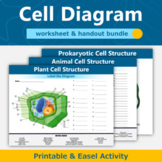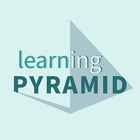 Show preview image 1" />
Show preview image 1" /> Show preview image 1" />
Show preview image 1" />
This resource includes a ready-to-use interactive activity students can complete on any device. Easel by TPT is free to use! Learn more.
My students loved labeling and coloring this prokaryote cell. We then compared it to Eukaryote cells and did a Venn Diagram to compare and contrast the cells.
Rated 5 out of 5 See all reviews
This bundle of diagram resources makes learning about the organelles and structure of plant, animal, and prokaryotic cells easy and engaging! Handouts with labels are provided, as well as fillable worksheets.Handouts and worksheets are provided in both color and black and white.These resource can be
$7.99 Price $7.99 $11.25 Original Price $11.25 Save $3.26 View Bundle
This resource makes learning about the structure of a prokaryotic cell easy and engaging! A handout with labels is provided, as well as a fillable worksheet.
The handout and worksheet is provided in both color and black and white.
This resource can be printed, or used digitally via the included Easel activity!
Total Pages Answer Key Teaching Duration Worksheets Activities Report this resource to TPTReported resources will be reviewed by our team. Report this resource to let us know if this resource violates TPT’s content guidelines.
Develop and use a model to describe the function of a cell as a whole and ways the parts of cells contribute to the function. Emphasis is on the cell functioning as a whole system and the primary role of identified parts of the cell, specifically the nucleus, chloroplasts, mitochondria, cell membrane, and cell wall. Assessment of organelle structure/function relationships is limited to the cell wall and cell membrane. Assessment of the function of the other organelles is limited to their relationship to the whole cell. Assessment does not include the biochemical function of cells or cell parts.
NGSS MS-LS1-1Conduct an investigation to provide evidence that living things are made of cells; either one cell or many different numbers and types of cells. Emphasis is on developing evidence that living things are made of cells, distinguishing between living and non-living cells, and understanding that living things may be made of one cell or many and varied cells.
NGSS HS-LS1-1Construct an explanation based on evidence for how the structure of DNA determines the structure of proteins, which carry out the essential functions of life through systems of specialized cells. Assessment does not include identification of specific cell or tissue types, whole body systems, specific protein structures and functions, or the biochemistry of protein synthesis.